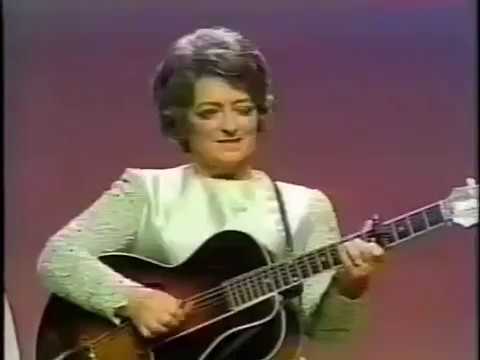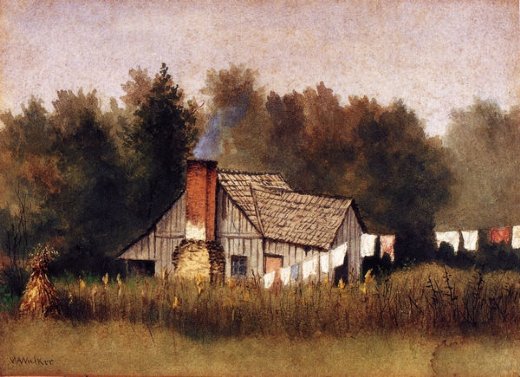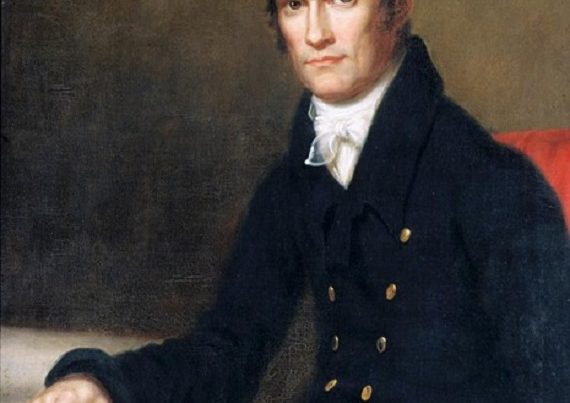
When I was a kid, we had a bully in school who delighted in picking on the girls, for some reason. No matter what they accomplished, this moron always chimed in with something like, “Not bad for a girl.” It was definitely not intended as a compliment. The obvious implication was that no matter what the females think they’ve achieved, they’re still in the minor leagues of society, and will never measure up to the boys no matter what they do. Second-class citizens all the way. That’s why I’m not a big fan of having separate lists, contests, or rankings of achievements based on gender (or anything else, really). That stupid kid made me realize that girls should never accept being measured up in any kind of lesser way than the boys, or else it justifies his position of, “not bad for a girl.” And that’s where Maybelle Carter fits in. Maybelle was not a great “female guitar player.” Maybelle Carter was a great guitar player, period. I realize that there aren’t a lot of iconic female guitarists out there to recognize, so it’s important to note the social significance of Maybelle’s accomplishments. However, I don’t think it is hyperbole to suggest that there would be no guitar bands of the 60’s and 70’s without Maybelle Carter.
Maybelle Addington was born in 1909 in Nickelsville, Virginia, in rural Appalachia, where the culture had not changed much at all over the past 150 years. Throughout the Jacobite Rebellions in Scotland and England, a significant influx of Scots-Irish refugees kept coming to the hills of Appalachia , and those Highland immigrants brought their language, customs, and especially music along with them, where it would remain tucked away and isolated. By the early 20th century, American folk music was an untapped motherlode of potential, and although it initially depended on the foreign lands from where its immigrants came, the music had grown outside the box and developed its own unique directions and sounds. Nowhere was this development more pronounced than in the South, and nowhere were the primary source sounds more intact than in Appalachia. British musicologist Cecil Sharp spent the years between 1916 and 1918 wandering through Tennessee, North Carolina, Kentucky, and Virginia collecting folk songs (notating them all by hand) and listening to dozens of local legendary performers. He published his findings with the observation that there were more authentic British folk songs to be found in Appalachia than in Britain.
At about the same time that Cecil Sharp was wandering the Appalachian hills and collecting songs, a musician named A. P. Carter, who was Maybelle’s brother-in-law, began doing the same thing. A.P. Carter was not interested in collecting songs for any musicology prosperity – he just wanted to learn them to perform with his musical act, The Carter Family. Instead of notating the songs by hand, A.P. brought along a friend, a black blues guitarist named Lesley Riddle who could memorize any song he heard, and then teach it to The Carter Family, which consisted of A.P. Carter, his wife Sara, and her cousin Maybelle. Maybelle was married to A.P. Carter’s brother, Ezra. Sara, Maybelle, and A.P. Carter sang, while Sara’s autoharp and Maybelle’s guitar provided the accompaniment. Occasionally, A.P. added a little fiddle.
In 1923, a New York City record executive named Ralph Preer set up some recording equipment in an Atlanta hotel room in order to record some local musical acts. With that one small event, the great profitable rush to capture Southern music began. Unlike Cecil Sharp, Preer was not capturing the song, which could easily be written down on music paper without the need for any recording equipment. He was capturing the performer’s actual sound, which provided the all-important context for the song to be valued. Music is, after all, a performance art. After some initial success from the Atlanta sessions, Preer returned to the South in 1927, and set up his gear in Bristol, Tennessee, which is just over the state line from Nickelsville, Virginia. This time, his musical fishing net captured two legendary musical acts – Jimmie Rodgers and The Carter Family – and these sessions have been described as the “Big Bang” of Country music.
For the first time, listening audiences outside the South were able to hear the authentic sounds of Appalachia, and they liked it very much. The recordings were highly popular and sold very well. The Carter Family exploded on the musical scene through those initial Bristol recordings, and their songs became primary source material for Country, Bluegrass, Gospel, and Folk music. Through their influence, Country music would always remain permanently connected to the music of Appalachia. Modern music performers claim their “influences” as a list of other performers they grew up listening to in one sound format or another that helped shaped their own sound. They may have never met those “influences” or even seen them perform live, but they definitely felt the impact due to the magic of recorded sound. However, those original recording artists were only shaped by the immediate people in their own lives. While Ricky Skaggs can list The Carter Family as one of his “influences,” The Carter Family could only list their own family, friends, and congregation as being their biggest “influences.” In their day, everyone was exclusively shaped by those immediately around them. It is through people like Cecil Sharp that we have access to Appalachian songs, but it’s through people like The Carter Family that we have access to real Appalachian music. Through them, we know what it’s all supposed to sound like, and every Country, Folk, and Bluegrass musician that followed was chasing The Carter Family. Likewise, every guitar player that followed was chasing Maybelle.
In The Carter Family, as mentioned earlier, A.P. did a little singing and fiddling, but mostly acted as arranger and “entrepreneur” of the band. His wife Sara did most of the lead singing and autoharp accompaniment, while Maybelle handled guitar, and make no mistake – Maybelle Carter was a force of nature on the guitar. She had a unique way of playing that was unlike the usual light, ukulele-style strumming that was so popular on guitar at the time. She would play either the melody or a counter-melody while strumming the chords, simultaneously! Additionally, she would sneak in a few bass notes with her thumb, and the effect of this style was an uncanny sound of multiple guitars coming from only one, and it was not unlike the old clawhammer style of playing the banjo, or the newly emerged Delta Blues style on the guitar. In her day, Maybelle would have been familiar with both, since she played banjo and learned blues guitar from Lesley Riddle. Her unique style was called “the Carter Scratch,” and with Maybelle playing both rhythm and melody, she forever changed the way guitars would be used in a band. Single-handedly, she made the guitar into a featured, lead instrument, a point from which we’ve never looked back.
The original Carter family stopped touring and playing in 1941, and Maybelle branched out on her own with her own three daughters as Mother Maybelle and the Carter Sisters. Here’s something to blow your mind – Maybelle hired a very young Chet Atkins to be her electric lead guitarist in the new group, and Chet ALWAYS took a back seat to Maybelle’s playing. Trust me, that’s unheard of. He certainly never did that for anyone else, that’s for sure. In the 1960’s, folk guitarists especially became entranced with her finger-picking style even though she didn’t understand all the fuss. As far as Maybelle was concerned, she just played the guitar the way you were supposed to. Many, many accomplished musicians who could simply hear something and instantly know how to play it were totally baffled by the Carter Scratch. Earl Scruggs – who was also a highly skilled guitarist himself – always had to get Maybelle to physically show him how to play it.
I will examine three recordings of Maybelle Carter’s that highlight and showcase her incredible performance talent on guitar. In addition, Maybelle could sing and play the autoharp extremely well, too, but it is her guitar skill on which I will focus.
“Bury Me Under the Weeping Willow”
This is the first song recorded by The Carter Family in those 1927 sessions in Bristol, Tennessee, and it set the bar firmly for every musician that followed. It is a folk ballad of unknown origin, and has been performed and recorded under various titles. It is in a verse-refrain format typical of folk ballads, containing four verses, each one followed by the refrain. All three of the Carters sing in tight harmony while Maybelle plays an infectious shuffle rhythm on the guitar, which for me, is as equally iconic as the Carter Scratch. I would know Maybelle Carter’s shuffle strum anywhere. After the second verse and refrain, Maybelle introduces the world to the famous Carter Scratch, as she continues strumming the chords while simultaneously playing the melody on the bass strings. It sounds like a second guitar has been added, because the shuffle strumming never stops or changes! As if that weren’t enough, Maybelle does it all over again after the third verse and refrain.
“Wildwood Flower”
I don’t know the exact year of this video appearance on the Grand Ole Opry, but my best guess is the early 60’s. Without question, this is Maybelle Carter’s signature song. Wherever Maybelle performed, everyone wanted to hear this song, and whenever anyone else played it, everybody instantly thought of Maybelle. It was just her song, plain and simple, and it will always be that way. The lyrics were probably written around 1860, but the melody is a much older Scots-Irish folk tune. As the song was passed down through the generations in an oral memory form, the lyrics grew into vastly different versions by the time The Carter Family recorded it in 1928. Although their version was far removed from the original, it’s the one that has stuck in everybody’s head as the “correct” one. I was highly amused by the various websites attempting to provide the song’s lyrics that struggled mightily with Maybelle’s Appalachian accent. “Life” was spelled “loft” on one site, “hair” was spelled “harr,” and “farewell” spelled “far well” on another. Bless their hearts. I chose this video because the television producers focused a camera directly on Maybelle’s guitar, and you can easily see her fingers in motion. The song has four verses and no refrain, and Maybelle plays the signature guitar part at the very beginning of the song and again after the second verse. That’s Earl Scruggs on guitar at the far left of the screen, by the way. As a guitarist, I am more mesmerized by Maybelle’s right hand that does all the strumming and picking, because it never looks like she interrupts her strumming rhythm in favor of the melody that is clearly coming from her left hand on the fretboard. How does she do that? If you turn off the volume and just watch her right hand, it looks like she’s simply strumming some chords. To watch her fingers, you’d never get the idea that she’s also playing a melody in addition to the strumming. Good grief, that’s not fair. That little device stretching across the strings about halfway up the neck of her guitar is called a capo, and it serves to raise the pitch of the whole guitar without needing to change fingerings or re-tune. Maybelle frequently changed the position of the capo from performance to performance, depending on which key fit her voice best that day. Based on the position of the capo on the 6th fret, it appears that Maybelle has chosen F# Major as the key for this particular performance. Even though her fingerings match C Major chord positions, by placing the capo on the 6th fret, she has shifted the key upwards by six half-steps, resulting in the performance being in F# Major. Ultimately, this gives her voice the trademark haunted, melancholy quality that Maybelle provided for this song. Ladies and gentlemen, THIS song is Appalachia, this song is the South, and this song is America.
“I’m Leaving You”
This recording was made in 1963 with Sara playing rhythm guitar and singing lead while Maybelle plays lead guitar and sings harmony. Sara would have been 65 at the time and Maybelle 54. By the way, Sara was every bit as much of a phenomenal singer as Maybelle was a phenomenal guitarist. Every Bluegrass guitar run you’ve ever heard Lester Flatt or Doc Watson play is all in this song in Maybelle’s fingers. It’s just stunning in its beauty, as she takes something nearly impossible to play and makes it sound so easy. You can hear that familiar shuffle strum of Maybelle’s throughout the whole song, as she uses it to accompany Sara’s singing and then her own lightning fast lead guitar when Sara’s not singing.
In 1970, The Carter Family became the first performing group voted into the Country Music Hall of Fame (what took so long?), which means that Maybelle and Sara were the first women voted in as well. Meanwhile, countless guitarists all over the world probably don’t even realize how much of their own playing is influenced by Mother Maybelle Carter – everything from that familiar shuffle strum to playing lead and rhythm simultaneously.
Not bad for a … Southerner.







